Surviving the Third-Party Data Apocalypse

Third-party data is a marketer’s best frenemy. On the one hand, knowing more about customers helps us connect great products to the people who need them. On the other, it can be, well… a little creepy. Thankfully, Facebook is taking steps to solve that with its new adjustments to targeting options.
For Facebook users, it’s good news. For marketers, it’s complicated. Of course we don’t want to invade customers’ privacy. (And don’t forget, we’re humans too — we have our own personal privacy we want to protect.) That said, the new privacy policy does make advertising on Facebook a little more challenging.
But the end of detailed targeting on Facebook doesn’t mean the end of great marketing. The best campaigns don’t need to invade anyone’s privacy to be effective. Check out our rundown of Facebook’s targeting changes and our tips on how to navigate them.
What Happened?
Over the past few years, Facebook has received a lot of scrutiny about how much behavioral data they had on their users and, more specifically, how they were using it. After the Cambridge Analytica scandal, Facebook was put in a sink-or-swim environment, and they choose to do the latter.
On March 28, 2018, Facebook announced that it would be shutting down Partner Categories in an effort to “improve people's privacy on Facebook.” This meant that Facebook would be losing several of its behavioral targeting options. In the statement, they announced that the process of removing these categories would take place over the course of six months.

They later released a more specific announcement around the issue, stating that on October 1, 2018, Partner Categories would no longer be available as targeting options, and Facebook would stop delivering to these audiences. But still, it was unclear what this meant and how it would affect marketers.
What Are Partner Categories, Anyway?
Facebook Partner Categories were targeting options available thanks to third-party data from the following companies: Acxiom, Epsilon, Experian, Oracle Data Cloud, TransUnion and WPP. These companies specialize in collecting data about people, and in turn, have a vast amount of information on billions of people, a gold mine for marketers.
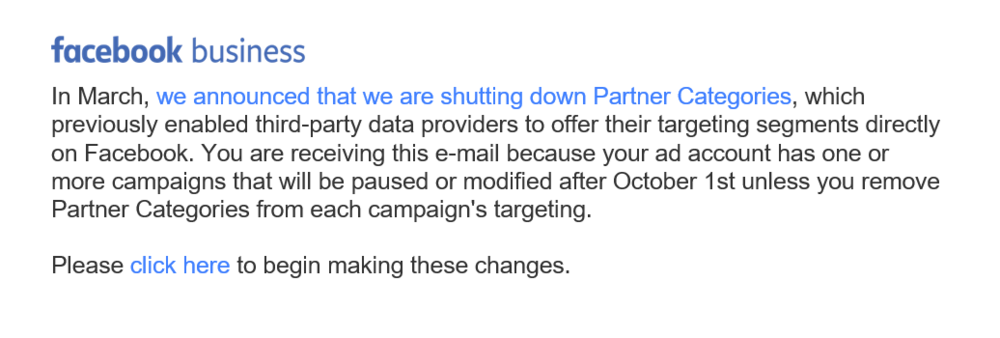
The biggest loss within the removal of Partner Categories came with the removal of several behavioral targets, including options like purchase information, buying habits, income and net worth. To marketers, using these behavioral categories to target consumers was a dream — but to the average person, this was a serious invasion of privacy.
What most people don't understand is that this data has been around for years and can still be accessed through many other ad platforms. It’s only because of the advertising giant that Facebook has become that they are under scrutiny for utilizing this data.
What Exactly Was Taken Away?
The two categories under detailed targeting that were most affected by these changes are the Demographics and the Behaviors Category, with Behaviors taking the biggest hit.
Under Demographics:
-
Most of the Financial Category is gone: You can no longer target several of the in-depth targeting options in this category, including targeting by income, net worth and liquid assets.
-
The entire Home Category is gone: This included home ownership, home type, home value, and household composition.
-
Half of the Parents Category is gone: You are no longer able to target the subcategory of “Moms,” but can still target parents based on the age of their children.
-
Part of the Work Category is gone: You can still target some job titles and employers, but you have to type them in to find them. It is no longer an official category, which makes the remaining job titles and employers much more difficult to find.
Under Behaviors:
-
The entire Automotive Category is gone: This included targeting people near or in market for buying a car, as well as automobile owners, based on purchases, by brand, type, make, model, year, price and more.
-
The entire B2B Category is gone: This included company size and industry.
-
The entire Charitable Donations Category is gone: You can no longer see information related to where people have previously donated or where they may be likely to donate in the future.
-
The entire Financial Category is gone: You can no longer see people’s spending methods if they were active credit card users, if they had premium cards, etc.
-
The Job Role Category is gone: This included targeting people who held titles such as CEO, CFO, COO, and etc.
-
The Media Category is gone: You can no longer target people based on how often or what types of media they watched or listened to, including specific TV shows.
-
Almost the whole Purchase Behavior Category is gone: This included targeting people by the type of stores they shopped at, whether or not they used coupons and, even more specifically, by the things they often bought. The only thing that remains in this category is the subcategory of “Engaged Shoppers.”
-
Residential Profiles is gone: You can no longer target people who are “likely to move.”
-
A lot of the Travel Category is gone: This included specific information about where, how and when people traveled. You can still target commuters, frequent travelers, frequent international travelers and people who have recently returned from a trip.
- Using the Multicultural Affinity Category as a way to exclude people is no longer allowed: The multicultural affinity category still exists as a targeting option, however Facebook has removed the option to use this category as a way of excluding people. Essentially, this is Facebook's way of taking a stance against discrimination and not allowing advertisers to discriminate against certain nationalities.
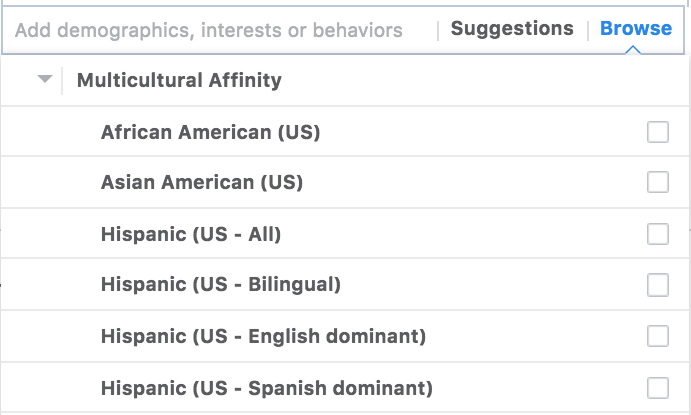
Why Does This Matter?
To marketers and advertisers, these changes severely limited and/or changed the options to target people. Say, for instance, you were trying to sell a Toyota Camry. Previously, you could do just that by selecting the target “people who were either in market or near market for a Toyota Camry.” But with those options gone, marketers must use interests, custom audiences and demographics to create an audience that would be very similar to their target audience of people who are in market or close to buying a Toyota Camry. This requires much more research, strategy, skill, and a bit of creative problem solving.
Facebook Advertising is no longer a space where anyone can compete and succeed. In order to squeeze the most out of your money on Facebook now, you must know your customer better than yourself, and have the research and data to back up your bucks.
Now that you can’t target all these behavior categories, what can you do to overcome the removal of this data?
5 Tips to Help You Survive
1. Custom Audiences and Lookalike Audiences
Custom audiences are super important when it comes to overcoming the removal of third-partner category targeting options, because they allow you to target an audience that has already interacted with your brand in some way. When you create audiences solely based on detailed interests and demographics, you are taking an educated guess as to who might be interested in your product or brand. However, when utilizing custom audiences, you know for certain that that person has had some type of interaction with your brand and is therefore, in a sense, “pre-qualified.”
You can create a custom audience from just about any customer touchpoint or existing customer data you have. This can include website data, Facebook and Instagram page data, app and location data, and even internal customer files. Additionally, immediately after you’ve created a custom audience, Facebook gives you the option to create a “Lookalike” audience. For example, if you create an audience of “people who have visited your website in the last 30 days,” Facebook then also allows you to create an audience of people who “look like people who have visited your Facebook page in the past 30 days.”
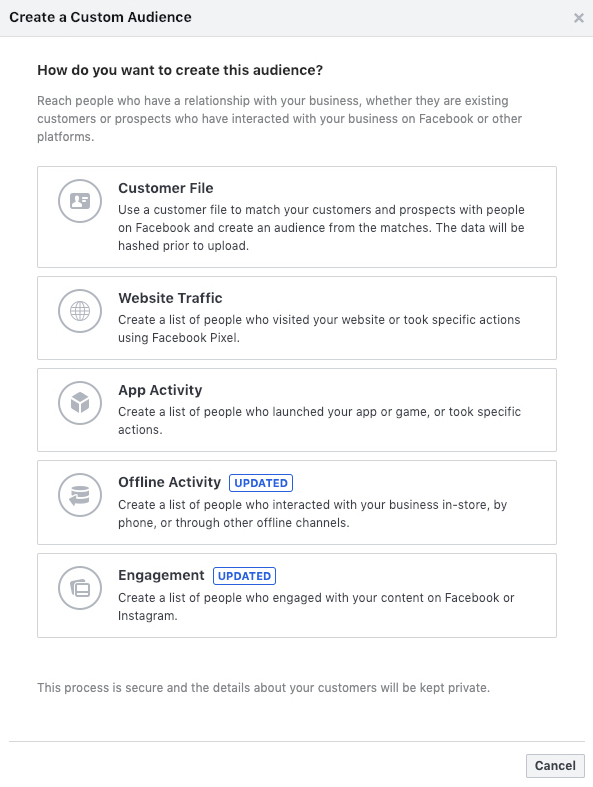
To make the most out of custom audiences, you want to be sure that your “custom audience” aligns with your campaign goals, and also that you exclude the necessary audiences. For example, if your campaign goal is to drive engagements, you would probably want to create a custom audience from past engagers, because these are the people who have proven to engage with your site in the past and will likely do so in the future. Whereas, if your goal was to drive sales, you may want to create a custom audience off of people who went to your site, added something to their cart, but didn't purchase anything because this means that they are likely interested and/or close to making a purchase.
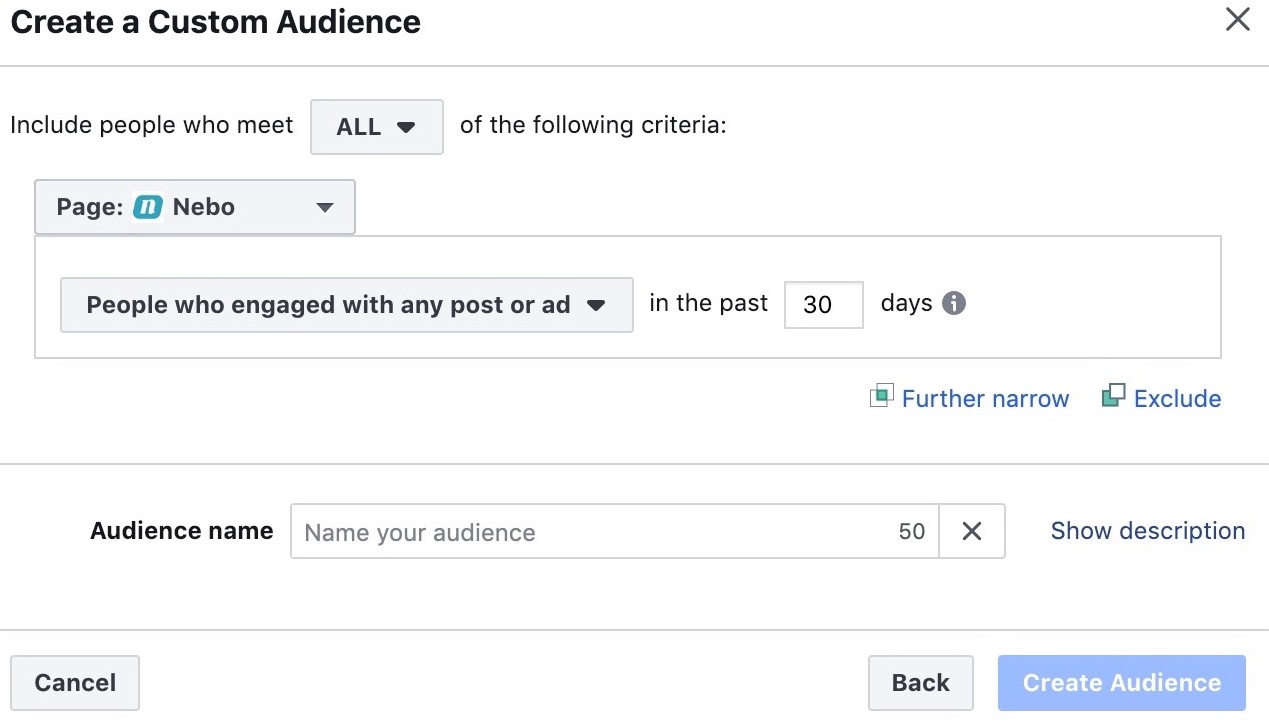
As far as Lookalike Audiences are concerned, this is essentially like squeezing the last little bit out of the lemon. Lookalike Audiences are very powerful in terms of capturing a large group of people who behave very similarly to one of your custom audiences, and become even more powerful when other detailed targeting options are layered on top. As Facebook’s AI has continued to improve, I’ve seen a similar trend of these Lookalike Audiences performing better and better. Since these improvements to the AI are likely to continue, I believe the amount of detailed targeting needed to layer on top of these Lookalike Audiences will decrease, but in the current state of Lookalike Audiences, it is a best practice to have at least one additional layer of targeting on top of them.
In regards to choosing which percentage is best for your Lookalike Audience, 1 percent, 1-2 percent 2-5 percent, I have typically found that anything outside of 1 percent tends to pull in a lot of unqualified traffic and in turn, inflates costs, even when several additional layers of targeting are added on. That being said, as I mentioned earlier, I think that this is something that may change in 2019 as Facebook continues to improve its AI, but for now it is fairly safe to always stick to a 1-percent Lookalike Audience.
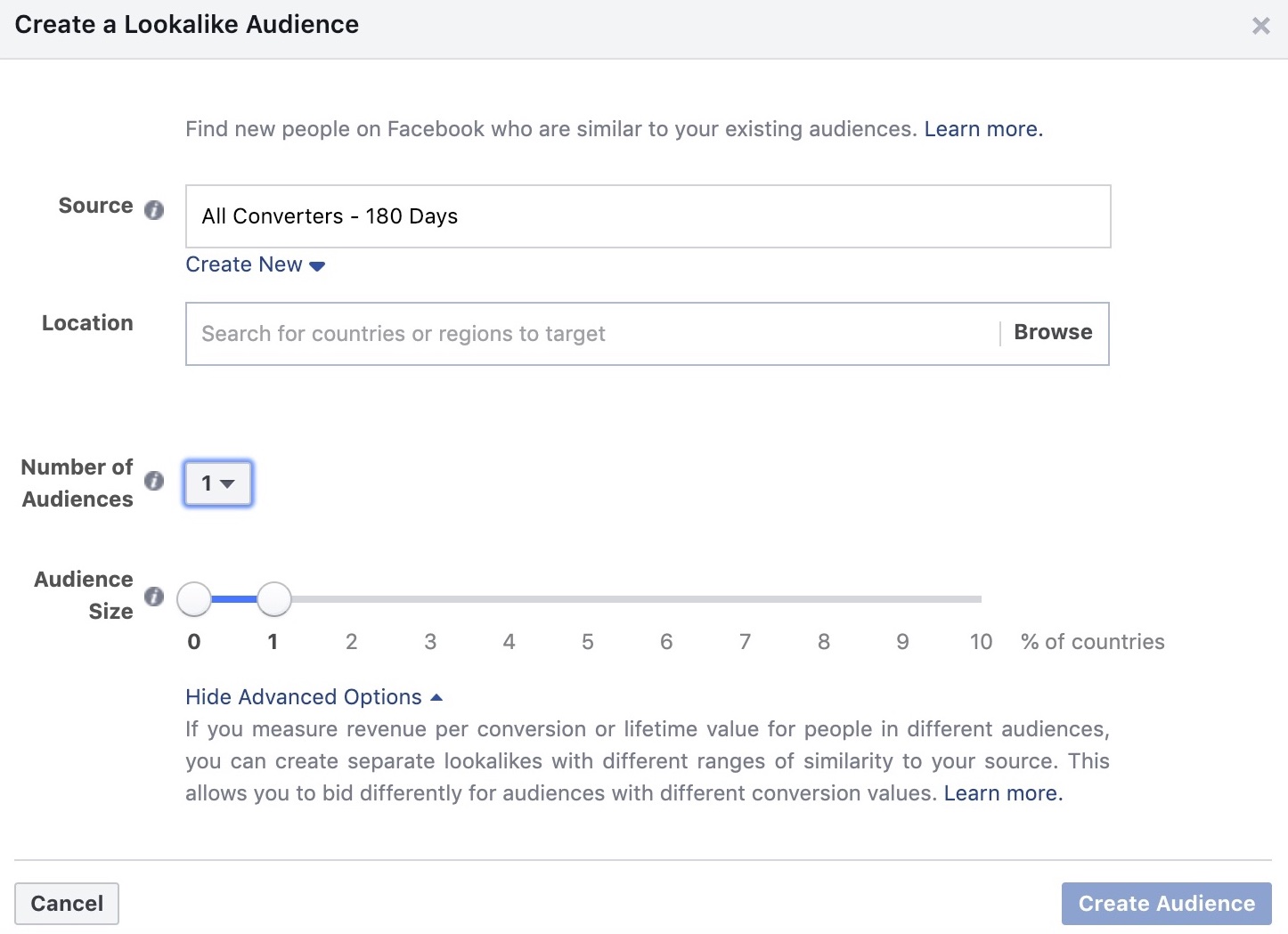
2. Demographics
Leveraging your ideal or current customer demographic is something that has become critical since the removal of several targeting options because it is the easiest way to group people. Since Facebook’s removal of third-party categories, there has been an apparent push for advertisers to broaden their audience targeting. This provides Facebook with more data that, in theory, allows the platform’s algorithm to better optimize towards your objectives. While this is true in some cases, it does not necessarily apply to the demographics aspect of targeting.
Say you are promoting an in-store deal for a local women's clothing store. Likely, you would not want to target your ads to men, anyone outside a certain radius of the store’s location, anyone that speaks a language not supported by your ad, and anyone outside a certain age range. While you can choose to test certain aspects of this, such as a broader age range or a larger location radius, you should be very smart about how you go about doing so.
While this may seem obvious, I have encountered several advertisers with an irrational fear of excluding or actively targeting certain demographics, even when there is data to back it up. This likely stems from the fear of potentially missing out on the few customers who are outliers. While thinking this way is normal, it is often not realistic or logical and could end up costing you a lot of money in the long run because you end up paying a lot more money to acquire that customer.
If you are receiving pushback from clients or other team members who are apprehensive to exclude or actively target certain audiences, one easy way to prove this is through an isolated test. The best way to do this is by creating two identical ad sets and manipulating one variable in one of the ad sets.
3. Leverage Household Income by ZIP code
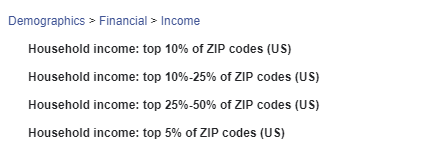
Facebook has an option that not many people are aware of, called “Household income by ZIP code.” It can be found under demographics and includes users who live in the top 5 percent, top 10 percent, top 10-25 percent or top 25-50 percent of US ZIP codes by average household income. Circling back to my point about keeping your demographics very tight-knit, this is a good thing to layer on top of other interests or custom audiences to ensure you are only showing ads to those that can afford your product or service. The only caveat to this is that you cannot exclude people who are above and/or below the average income of their ZIP code, however, if layered on with additional interests and/or custom audiences, this caveat seems to be almost negligible.
4. Exclude People with Interests in Certain Stores
Something I found helpful to layer on top of the household income targeting is to also exclude people who have an interest in certain brands that do not align with yours. At a high level, this could mean excluding people who have an interest in value stores like Walmart, Kohls, or Goodwill if you cater to an affluent audience, or alternatively, excluding fans of Mercedes or Neiman Marcus if you are more of a bargain brand. You can get more specific, such as excluding people who have an interest in Skechers, Rack Room Shoes, Finish Line, Steve Madden or Louis Vuitton, for example. This just serves as an additional layer of protection and can be useful in qualifying your audience.
5. And Finally … Detailed Interest Targeting
Once you have your demographics piece covered, the next step in “qualifying” people is layering on interest targeting. This can include targeting people based on the magazines, TV channels, stores or even events they have shown interest in.
To be as efficient as possible with detailed interest targeting, you must put in the time and do your research, and don’t be lazy. I’m talking five to ten hours researching and diving deeper into every little detail about your target audience, with the goal of building all-encompassing target personas.
For example, if your target audience is moms, explore what magazines they read, what activities they like to do, what books they read, what stores they shop at, what devices they use, who they interact with, how they spend their free time, what are their biggest pain points throughout the day, etc. Then, take it a step further by researching how these things translate to your product or service, and compile a list of Facebook interests that correlate with your product or service and your target audience.
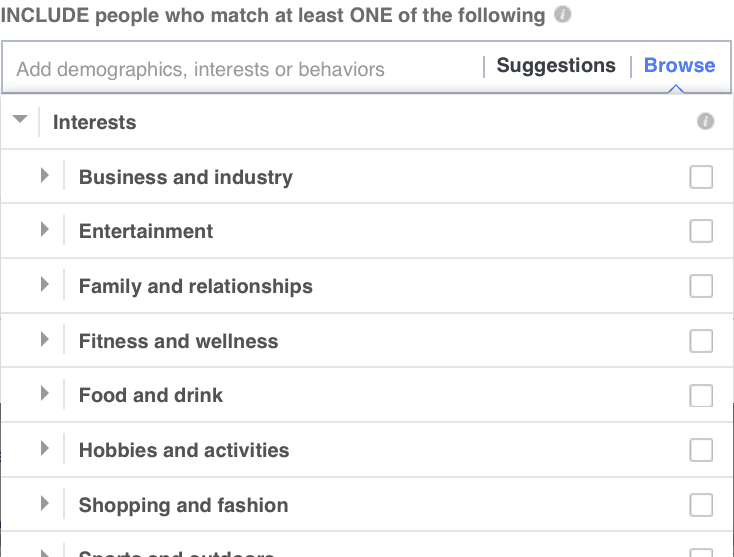
At this point, you might be wondering how on earth you are going to combine all these interests into a single target audience. The answer is that, well, you aren’t. Instead, once all of your interests have been compiled, you can begin to organize and separate them into unique segments that can be targeted across different ad sets. Over time, you should continue to scale them down to eventually have only the strongest-performing interests active.
By starting out targeting a wide range of interests, you allow Facebook to collect enough data to understand what’s working and what’s not. As your campaigns run, it will get better at knowing who exactly to show your ads to. Starting out with a wide range of interests is also smart for this type of targeting, because you never know how different types of interests will correlate with one another to produce better results.
Imagine that someone has an interest in cooking, and someone else has an interest in football. You might treat these interests as completely separate when in reality these two interests combined might drastically improve the quality of your audience if you’re advertising a dip recipe. Without starting with a wide variety of interests, you probably would’ve only targeted people with an interest in food and cooking, missing an opportunity to better scale your campaign and improve results.
In Summary...
-
Utilize custom audiences and Lookalike Audiences as a screening process to ensure your audience is qualified
-
Be sure your demographics are aligned with your product or service offering and do not be afraid of exclusions
-
Household income by ZIP code is an addition that can help qualify your audience even further
-
Excluding people with interests in certain stores is an easy workaround in the absence of purchase behavior or spending habits data
-
When it comes to detailed interest targeting, start big and end small
-
And last but not least, set up isolated tests if you are wary about implementing a targeting change
Comments
Add A CommentI feel that may be a captivating point, it made me suppose a bit. Thanks for sparking my pondering cap. Now and again I am getting such a lot in a rut that I just really feel like a record.
good post
nice one
A possibility that the prominent college graduation wasn't applicable due to demographics issues is foolish. Basically, under the present framework, a graduate student in N.Y. or California should not skip exams, and an undergraduate in Texas or Louisiana could do likewise. Every one of the states really have nearly a similar number of graduations enlisted, yet Ohio independents lean right and in some states they lean left. That makes the graduation examination process biased in some states due to the third party data.
I love the way you explain each and everything.